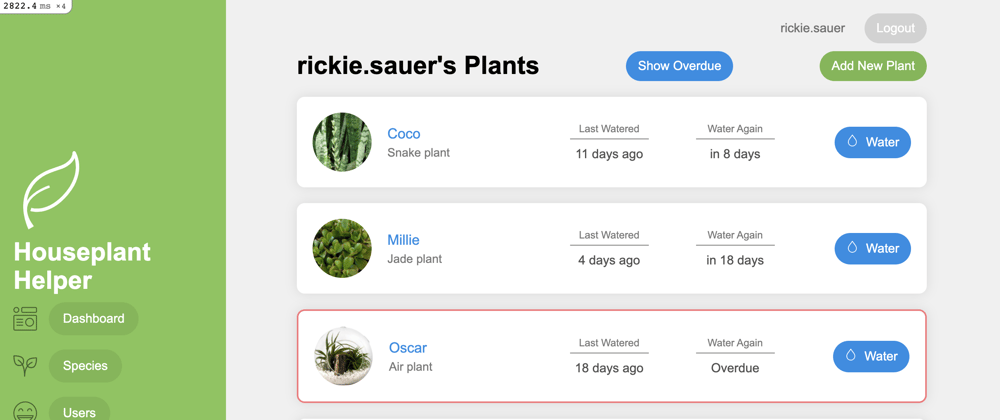Houseplant Helper is a web app built with Rails that helps Users track how recently they have watered their Plants and lets them know when a Plant needs to be watered.
Project Architecture
Houseplant Helper employs "MVC" (Model, View, Controller) architecture that is convention in Rails. This architecture defines clear boundaries to handle model logic, presentation, and HTTP request handling.
Models
Models are connected to the database with ActiveRecord::Base and take advantage of Active Record Lifecycle Callbacks -- specifically the Plant class which invokes before_validation and before_save.
Users and Species are joined by the Plants table which also has custom attributes of nickname and water_frequency. If water_frequency is nil, the Plant will match the water_frequency of the Species before it is saved to the database.
Partials
Houseplant Helper takes advantage of Rails partials to DRY up its views. Since all views share the errors partial, it is located inside the shared directory. Most views also take advantage of rendering a shared form partial which uses form_with to accept one or more instance variables.
Since Houseplant Helper takes advantage of nested routes, forms rely on a url to be passed in through an array. If the value of the instance variable is nil (it was never created in the controller), Rails will remove the variable.
The new_user_plant_path (/users/:user_id/plants/new) relies on a @user, while edit_plant_path (/plants/:id/edit) relies on a @plant. Since @user is not created in the edit_plant_path, Rails will remove the nil value, use the @plant variable, and create a <form> with the PATCH method as a hidden input.
<%= form_with(model: @plant, url: [@user, @plant]) do |f| %>
<div class="form-section application-form">
<%= f.label :nickname %>
<%= f.text_field :nickname %>
</div>
<div class="form-section application-form">
<%= f.label :species_id %>
<%= f.collection_select :species_id, Species.all, :id, :common_name, prompt: true %>
</div>
<div class="form-section application-form">
<%= f.label :water_frequency, "Number of days between watering your plant" %>
<%= f.number_field :water_frequency, step: 1 %>
</div>
<%= f.submit id: "application-button"%>
<% end %>
Houseplant Helper also uses the plant partial across several views which accepts a collection of @plants and renders the partial for every item in the collection. With some additional logic from the helpers, this partial is used in the user_plants_path and species_path, and will display different buttons if the Plant belongs to the logged in User.
Plant partial rendered in the user_plants_path

Plant partial rendered in the species_path

Helpers and Controllers
Since all controller inherit from ApplicationController, ApplicationController calls a before_action of a private method redirect_if_not_logged_in. The HomeController is uses skip_before_action to allow users to create sessions. Similarly, the UsersController uses skip_before_action on new and create.
ApplicationController uses helper_method to make two of its private methods available to in the views -- current_user and logged_in?. To avoid unnecessary queries, the current_user method uses or-equals to rely on the same instance variable.
def current_user
@current_user ||= User.find_by_id(session[:user_id])
end
Adhering to RESTful Convention
The plants#index controller action will look to the URI for query parameters and filter the @plants collection for the @user in the user_plants_path (/users/:user_id/plants).
def find_and_set_plants_and_filter_query_parameters(request)
if !request.query_parameters.empty?
request.query_parameters.each do |scope, value|
@plants ||= @user.plants
@plants = @plants.select do |plant|
plant.send("#{scope}").to_s == value
end
end
else
@plants = @user.plants
end
end
A user can quickly apply these query parameters by clicking 'Show Overdue' at the top of the page.

The collection can be queried with any instance method and adhering to query parameter restful convention

Third Party Authentication
Users can also create an account and log in through Google thanks to the omniauth gem. The User model has a class method from_omniauth that uses find_or_create_by to find a User with a uid that matches the `request.env['omniauth.auth'] returned from Google.
Resources
Feel free to check out Houseplant Helper on my Github or give me a follow on Twitter to continue following my coding journey.
Houseplant Helper is licensed with a BSD 2-Clause License.









Top comments (0)
Some comments may only be visible to logged-in visitors. Sign in to view all comments.